London Summer Olympics US TV Ad Spend Reached $1.33 Billion, Rio Set to Break the Record?
August 13, 2016
![]() The Games of the XXXI Olympiad are in full swing in Rio de Janeiro, marking the first time an Olympics has been held in South America. While the road to Rio has sometimes been filled with controversy and adverse publicity, it’s still the Summer Olympics and continues to attract a large viewing audience who are following on both TV and digital platforms.
The Games of the XXXI Olympiad are in full swing in Rio de Janeiro, marking the first time an Olympics has been held in South America. While the road to Rio has sometimes been filled with controversy and adverse publicity, it’s still the Summer Olympics and continues to attract a large viewing audience who are following on both TV and digital platforms.
Though the main focus remains on the athletes and their performances, another competition is taking place among advertisers trying to leverage the Olympics for the benefit of their brands. Like the athletes, the sponsors also hope to cross the finish line and earn marketing gold. But unlike the athletes, several sponsors launched their Olympics campaigns even before the Games began, including Bridgestone, BMW, Citi, Chobani, Coca-Cola, Liberty Mutual, P&G and Visa amongst others.
Kantar Media has mined its extensive database to compile a variety of statistics and insights on Summer Olympic advertising. Ad volume and revenues were already comparatively high for the 2012 Games, positioning Rio to reach new heights. NBCUniversal has stated their networks and digital platforms will serve up some 6,755 hours of programming for the Games, or roughly 356 hours of coverage per day over the course of 19 days – a significant increase over Summer 2012. With so many new opportunities for brand engagement, it’s likely that the 2016 Games will also prove to be a record-breaker: Indeed, NBC has stated that it’s already secured $1.2 billion in national ad revenue, and expects ad revenues will be around 20% ahead of the London games.
2012 TV Ad Revenue Hits a Record
National TV ad spending in the 2012 Summer Olympics reached a record of $1.33 billion (edging the previous high of $1.29 billion set in 2004) and generated the most TV ad revenue of any sporting event that year. These results represented a sharp increase from 2008 ad revenues, when a looming recession led to lower ad rates. Digital advertising brought in an additional $60 million in 2012 according to NBC Universal (NBCU).
The closest competitors in 2012 were the NCAA Men’s Basketball Tournament, which was supported by $1.01 billion in TV ad money, and the NFL post-season (including the Super Bowl), which generated $976 million. In 2016, those two events produced $1.21 billion and $1.37 billion of TV spending, respectively. We’ll soon know whether the Rio Summer Olympics eclipses these amounts to remain atop the TV sports podium.
The London Games also set another record with NBCU airing 1,023 hours of Olympic coverage on its broadcast and cable TV networks, an increase of nearly 25 percent from the 2008 Summer Olympics.
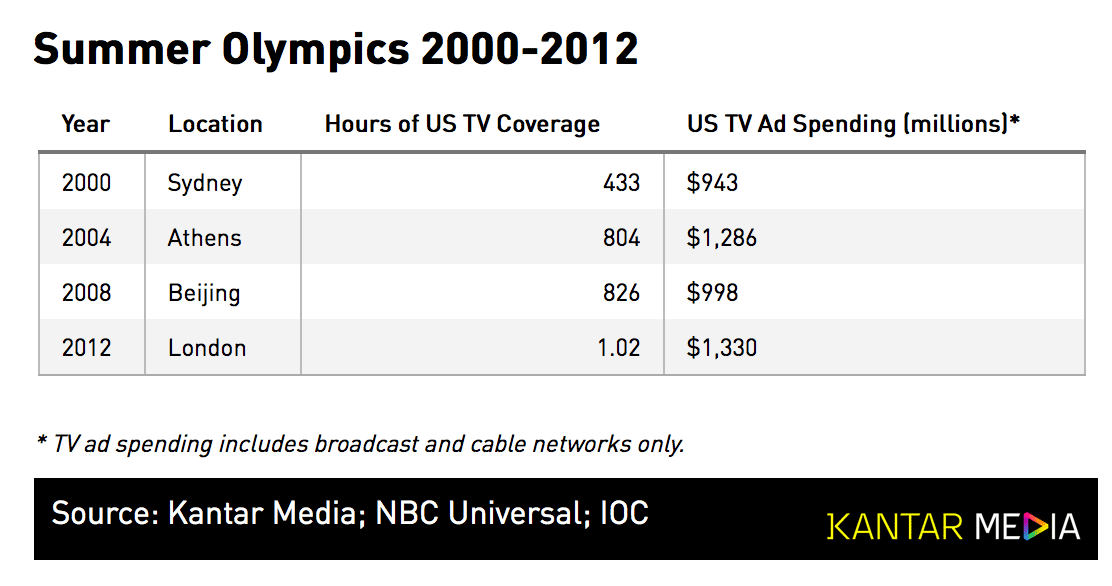
Media Rights Fees Have Increased 175% In Twenty Years
Domestic rights fees for the Summer Olympics have increased 175% over the past twenty years, and broke the billion-dollar threshold for the London Games.
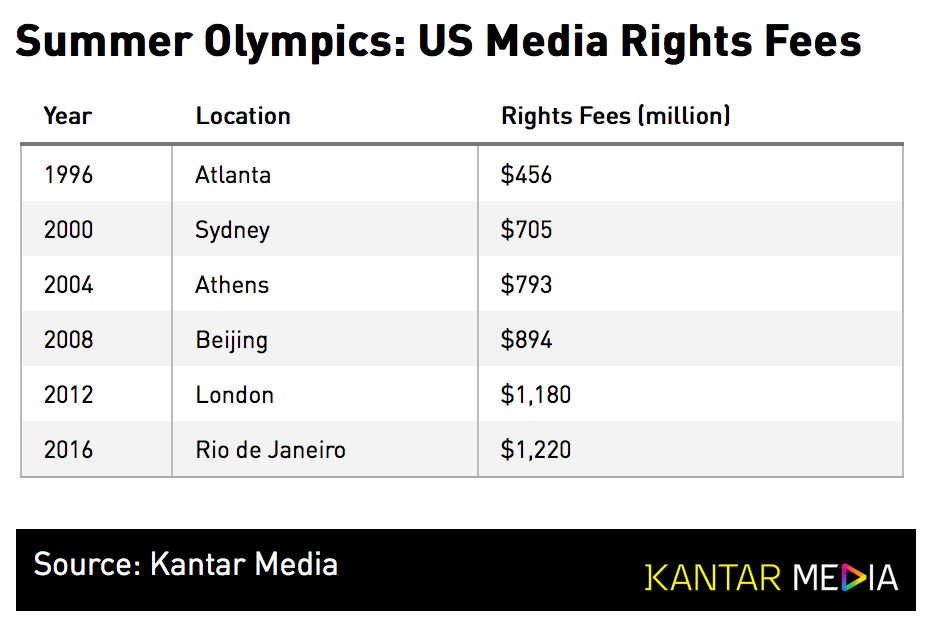
Future fees will be going up at a much slower pace. The International Olympic Committee (IOC) pairs a Winter and Summer Games together and sells the media rights as a package. NBCU, which has the U.S. rights locked up through 2032, will see its fees increase from $2.0 billion for the 2014-2016 pairing to $2.6 billion in 2030-2032 for an average increase of 7 percent per cycle.
More Hours of Coverage Equals More Ad Inventory
As linear TV coverage of the Summer Olympics has expanded, so have opportunities for commercial time. The growth has been driven by expanded coverage on NBCU cable and Spanish language properties. At the 2012 London Games, 74 percent of programming hours and 76 percent of ad time were on these complementary channels.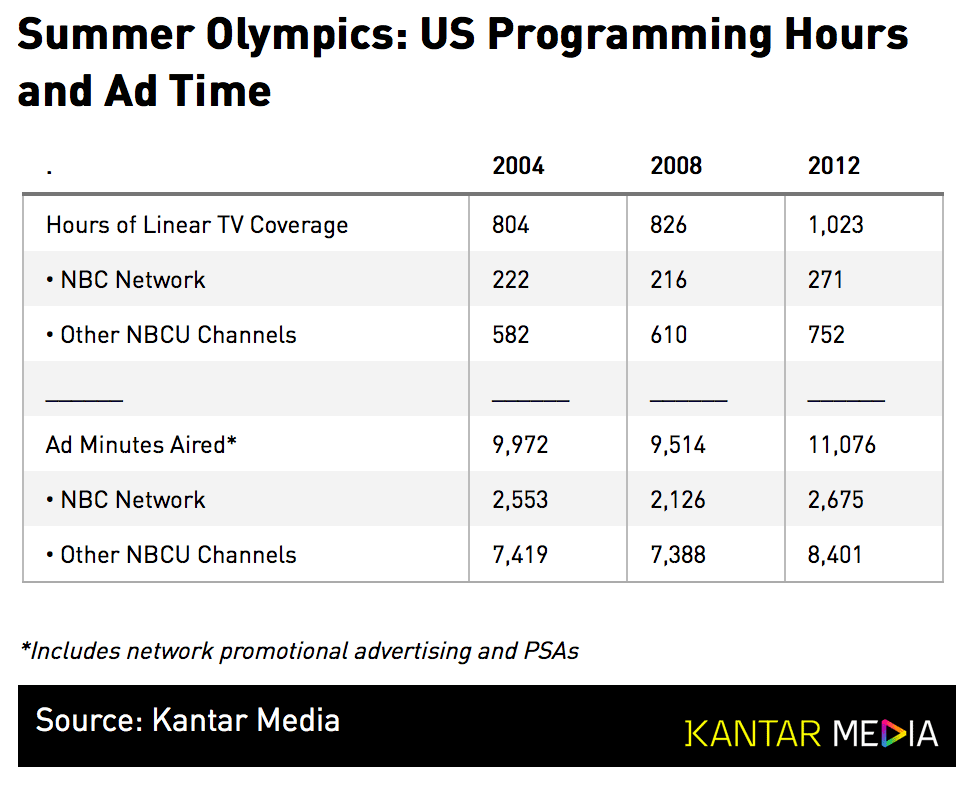
Despite the diffusion of Olympics programming, the NBC broadcast network gets an overwhelming majority of the viewing and this remains true in 2016. The drawing power of NBC is aided by its showing the popular swimming, diving, gymnastics and track and field competitions. In addition, the sister networks have traditionally finished their daily Olympics coverage by 8 pm, leaving a clear field for NBC’s primetime telecasts. (There will be some primetime cable programming from Rio focused on niche sports).
In 2012 the NBC telecasts had an average 20 percent more paid ad time per hour as compared to cable networks on a like-for-like daypart basis. Within NBC’s full-day Olympic schedule, primetime had the heaviest ad load of any daypart. Squeezing more sponsor message into higher-rated programming is an established monetization strategy.
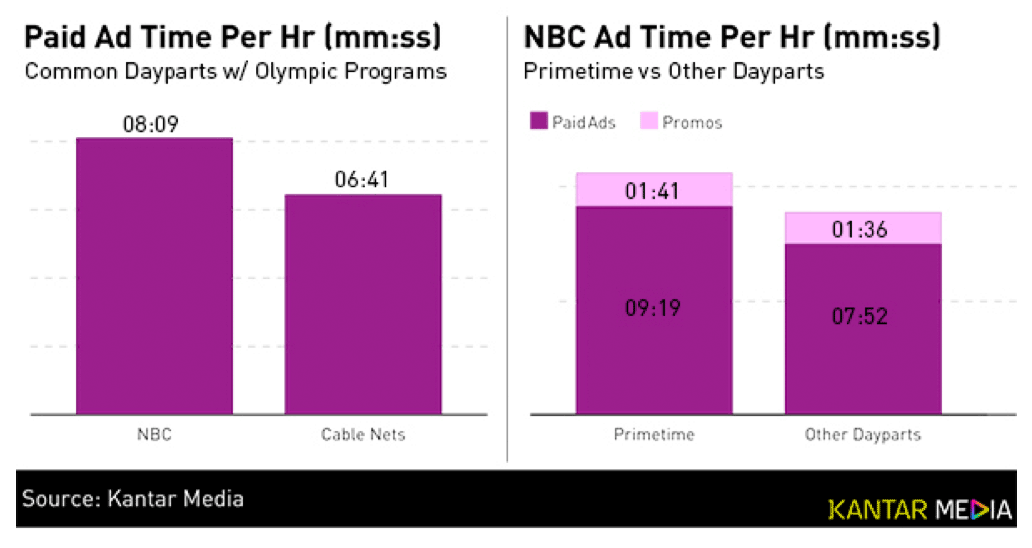
Due to the combination of larger audiences and more ad time, the NBC network by itself accounted for approximately 90 percent of commercial audience delivery in the 2012 Olympics. NBC primetime was responsible for about 45 percent.
Ad Pricing
The blended average price for a 30 second unit in the 2012 Summer Olympics, across all network and cable channels, was $93,200. The amount paid by individual marketers can vary considerably depending on a variety of factors. These include how much ad time is purchased, the mix of premium and non-premium inventory, sponsorship positions and packaging of TV spots with digital inventory.
One outcome of more programming content is audience fragmentation as viewers distribute their Olympic viewing across the expanding array of linear and digital options, leading to declines in average unit rates given the lower available audience. However, having more choices can increase the aggregate number of Olympics viewers even as the average audience per channel and per spot declines. Ad revenue growth thus becomes more dependent on volume than average price.
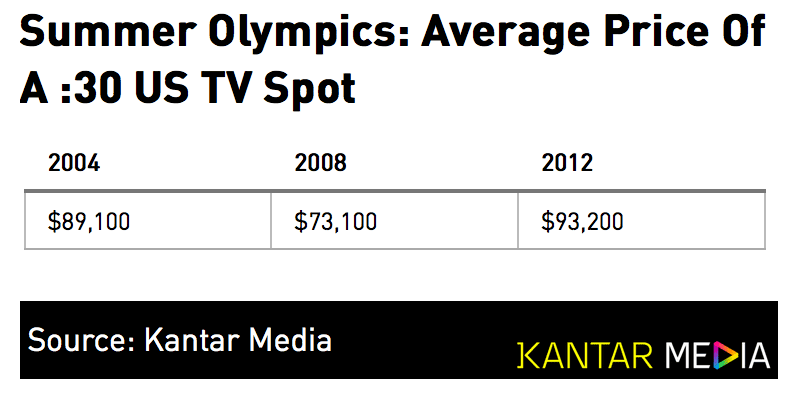
A Concentration of Ad Spending
The number of marketers buying TV time in the 2012 Games declined, as compared to the prior two Summer Olympiads, and spending became more concentrated among the Top Ten sponsors.

Many top-tier sporting events are experiencing a similar consolidation of TV ad spending. Marketers are attracted to these properties for the many benefits they offer including sponsorship opportunities, category exclusivity, building integrated multi-channel programs and a DVR-proof viewing audience. With these extra elements come additional costs, including the price of TV spots. Advertisers with deep pockets are in a stronger position to execute this strategy and in doing so they are squeezing out other marketers.
Leading Advertisers
The ten largest TV advertisers in the 2012 Olympics spent a total of $596 million. In each Olympics most of the top spenders also have top-level sponsorship deals with either the global IOC or the domestic United States Olympic Committee (USOC). These positions entitle companies to different marketing rights in various regions, category exclusivity and the use of designated Olympic images and marks.
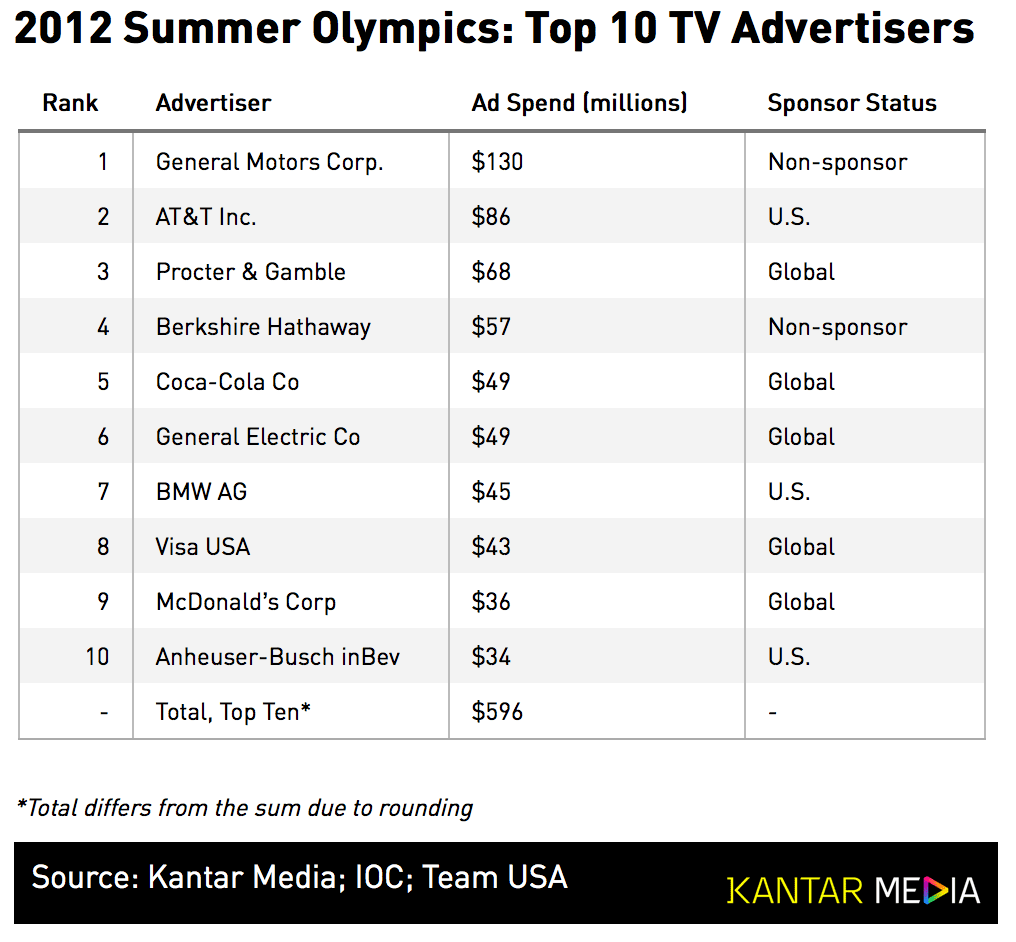
In total, the 2012 TV advertiser roster included 21 global and domestic Olympic sponsors. Their aggregate expenditures were $621 million, which was nearly one-half of the $1.33 billion invested in the event.
Top Ad Categories
The leading ad categories in the Summer Olympics are a reflection of the Top Advertiser list, since many of these companies have exclusivity deals that limit access by their main rivals. The Top 5 categories in 2012 spent $561million and accounted for 42% of the total TV ad revenue.

The Endorsement Olympics
For many spectators and fans the Olympics is primarily a competition among athletes for gold, silver and bronze medals. But for elite athletes it’s also a high-profile stage to translate their talents and appeal into corporate sponsorships and an income. This parallel competition is of great interest to marketers.
Prior to the Rio Games, IOC rules permitted only official corporate partners to run ads featuring Olympic athletes during a defined blackout period surrounding the Games. The threat of penalty was borne by the athletes in the form of disqualification and sanctions. But a recent rule change by the IOC in response to lobbying efforts by athletes has created an optional but narrow pathway allowing non-partners to use Olympians in their ad campaigns during the Games.
Companies running these campaigns must secure IOC approval and adhere to restrictions intended to preserve some advantages for paying corporate partners. The campaigns had to be in-market by March 27th and run continuously through the end of the Rio Olympics, a period of five months. (Many of the companies have used Owned Media, rather than paid media, to fulfill this requirement). Ad messages must be “non-Olympicized” and avoid language or images that tie the brand to the Games, restrictions that don’t apply to non-partners who choose instead to accept the Olympics blackout period.
In effect, a non-Olympic partner can spend money on a generic campaign that runs during the Olympic Games but says nothing about the Olympics. As a result, some non-partners who pursued IOC approval are featuring well-known athletes that the viewing public associates with the Olympics. In some cases, these endorsers also have contracts with official corporate partners. For example:
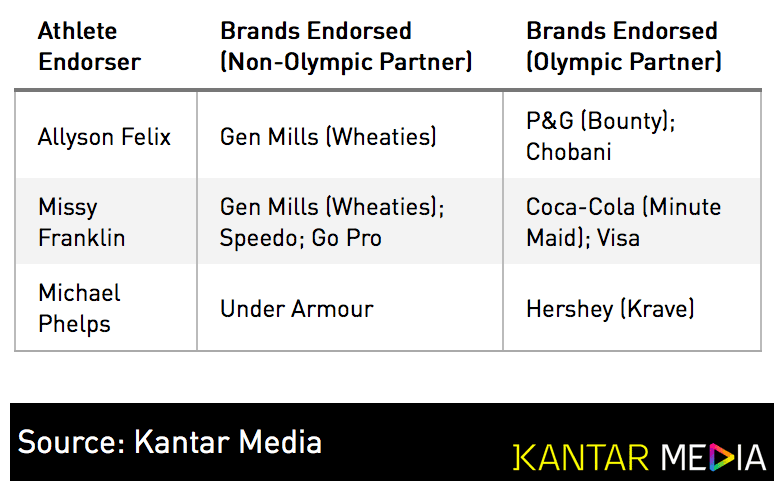
As the athletic competition unfolds on the track, water, courts and fields in Rio, Kantar Media will be monitoring the parallel “Endorsement Olympics” and the amount of ad spending connected to Team USA participants in addition to trends in who’s advertising and how much they’re spending on the Rio Games. Visit kantarmedia.com to see our latest analyses throughout the Games.






























